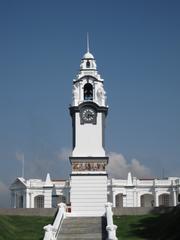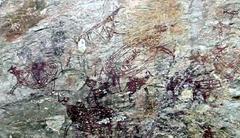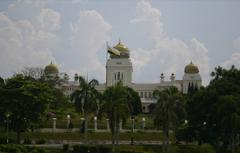
Beruas Museum: Visiting Hours, Tickets, and Your Complete Guide to Perak’s Historical Sites
Date: 04/07/2025
Introduction
The Beruas Museum, located in the historic town of Beruas in Perak, Malaysia, invites visitors to explore the fascinating legacy of the ancient Malay kingdom of Gangga Negara. Renowned for its archaeological treasures and its role as a center for cultural preservation, the museum offers a comprehensive journey through the region’s pre-Islamic origins, its evolution under Malay sultanates, and its transformation during the colonial era. Housed in a thoughtfully repurposed colonial-era courthouse, the Beruas Museum is both a repository of over 300 artifacts and a symbol of ongoing heritage conservation in Perak.
This detailed guide covers everything you need to plan your visit—from up-to-date Beruas Museum visiting hours and ticket information to accessibility features, highlights of the museum’s collection, and tips for exploring nearby historical attractions in Perak.
For further details and official updates, visit the Muzium Perak website, the Malaysia Traveller’s Beruas Museum guide, and the Malaysia Vacation Guide.
Table of Contents
- Introduction
- Historical Background
- Visiting Information: Hours, Tickets, and Accessibility
- Museum Architecture and Setting
- Exhibitions and Visitor Experience
- Community Engagement and Conservation
- Nearby Historical Sites and Attractions
- Recent Developments and Exhibition Updates
- Educational and Research Value
- FAQs
- Conclusion & Call to Action
- References
Historical Background
Origins of Beruas and Gangga Negara
Beruas’s significance is rooted in its association with the ancient kingdom of Gangga Negara, a polity believed to have flourished from the 6th to the 11th centuries CE (Malaysia Traveller). The kingdom’s name—“City of the Ganges”—reflects strong Indic influences, a testament to the Indianization of Southeast Asia during that era. Archaeological finds, oral traditions, and historical research, including the Beruas Historical Survey Project, all point to Beruas as a vital early center of Malay civilization (Visit Perak).
Following the decline of Gangga Negara, Beruas continued to evolve as a prominent Malay kingdom, playing a key role in the spread of Islam and the development of local governance structures.
Archaeological Discoveries and Key Artifacts
Extensive archaeological work in the Beruas district has yielded a diverse collection of artifacts, now housed in the museum. Notable items include:
- Ceramics & Pottery: Locally produced earthenware and imported Chinese porcelain shards from as early as the 10th century CE, reflecting Beruas’s involvement in international trade.
- Metal Objects: Bronze and iron tools, weapons, and ritual objects, some linked to the Gangga Negara period.
- Stone Inscriptions & Tombstones: Early Islamic tombstones and inscribed stones, illustrating the region’s transition from Hindu-Buddhist to Islamic influences.
- Maps & Illustrations: Wall displays and maps that contextualize the shifting boundaries and political centers of Beruas and the Manjung district (Visit Perak).
These artifacts underscore Beruas’s importance as a cosmopolitan hub in the regional trade and metallurgical networks that connected the Malay Peninsula with India, China, and beyond.
Beruas in the Context of Malay Kingdoms
The museum’s galleries trace Beruas’s journey from a Hindu-Buddhist kingdom to an Islamic sultanate and, eventually, to its integration under British colonial administration. Its strategic coastal location made it a magnet for traders and a center for tin and iron production, further shaping the region’s economic and cultural landscape.
Trade, Metallurgy, and Regional Influence
Artifacts such as tin ingots, iron tools, and imported ceramics reveal Beruas’s technological prowess and its role in the ancient global economy. The area’s advanced metalworking skills and broad trading connections are a recurring theme throughout the museum’s exhibits (Malaysia Traveller).
Visiting Information: Hours, Tickets, and Accessibility
Opening Hours:
- Tuesday to Sunday: 9:00 AM – 5:00 PM
- Closed on Mondays and public holidays
Admission Fees:
- Adults: RM5
- Children and students: RM2
- Senior citizens and disabled visitors: Free
- (Note: Please check the official announcement for the latest updates on ticketing and operating hours as these may be subject to change.)
Accessibility:
- The museum is fully wheelchair accessible, with ramps and accessible restrooms.
Location & Getting There:
- Jalan Besar, 32700 Beruas, Manjung District, Perak, Malaysia
- Approximately 1.5 hours by car from Ipoh; parking is available nearby.
Best Time to Visit:
- Weekday mornings offer a quieter experience.
- The museum is especially lively during cultural events and special exhibitions.
Museum Architecture and Setting
Beruas Museum occupies a single-storey building that once served as a colonial courthouse, representing a successful example of adaptive reuse in heritage conservation (Wikipedia; Malaysia Vacation Guide). The structure retains elements of mid-20th-century Malaysian civic architecture with a low-pitched roof, clean lines, and practical design. The museum blends seamlessly with Beruas’s townscape of traditional Malay wooden houses and colonial-era buildings (Visit Perak).
Inside, exhibition spaces are arranged chronologically and thematically, enhanced by interpretive notes and carefully managed lighting to protect sensitive artifacts (Muzium Perak).
Exhibitions and Visitor Experience
- Permanent Galleries: Focus on the history of Gangga Negara, the Beruas Kingdom, regional trade, and metallurgy.
- Key Artifacts: Ceramics, metal tools, weapons, religious objects, and stone inscriptions.
- Interactive Elements: Illustrated maps, multimedia presentations, and digital displays on maritime trade routes.
- Guided Tours: Available occasionally; check with the museum or local historical societies for schedules.
- Family-Friendly: Activities and scavenger hunts for children; non-flash photography is allowed except in sensitive areas.
- Museum Shop: Offers books, replicas, and locally crafted souvenirs.
Information is presented in both Malay and English to ensure accessibility for all visitors.
Community Engagement and Conservation
The museum’s establishment was the result of collaboration between the Perak State Government, the Department of Museums and Antiquities, Universiti Kebangsaan Malaysia, and local historical societies (Muzium Perak). It serves as both a cultural anchor for the community and a resource for education and research. Oral histories, traditional crafts, and local legends are woven into the museum’s interpretive framework, celebrating both tangible and intangible heritage.
Nearby Historical Sites and Attractions
- Kota Lama Beruas: Remnants of ancient Malay fortifications, just a short distance from the museum.
- Traditional Malay Houses: Explore the unique wooden and colonial-era architecture within Beruas.
- Local Markets & Eateries: Experience authentic Perak cuisine and crafts.
- Natural Attractions: Rivers and green spaces nearby, ideal for nature walks and boat rides.
Recent Developments and Exhibition Updates
As of 2024, the Beruas Museum features refreshed exhibitions that incorporate recent archaeological discoveries and new research, ensuring a dynamic and up-to-date visitor experience (Muzium Perak).
Educational and Research Value
The Beruas Museum’s collections are used by scholars and students for research into early Malay civilization. The museum’s interpretive materials are based on the latest findings, and its partnerships with academic institutions continue to advance the study of Southeast Asian history (Visit Perak).
Public education initiatives, including temporary exhibitions, lectures, and workshops, foster greater historical literacy and community engagement.
Frequently Asked Questions (FAQ)
Q: What are the Beruas Museum’s opening hours?
A: Tuesday to Sunday, 9:00 AM–5:00 PM (closed Mondays and public holidays).
Q: How much are tickets?
A: RM5 for adults, RM2 for children and students. Senior citizens and disabled visitors enter free.
Q: Is the museum wheelchair accessible?
A: Yes, with ramps and accessible restrooms.
Q: Are guided tours available?
A: Occasionally, and during special events. Check the museum’s website or contact them for details.
Q: Can I take photos?
A: Non-flash photography is permitted except in areas with sensitive artifacts.
Q: What are the must-see exhibits?
A: Ancient ceramics, metal artifacts from the Gangga Negara period, Islamic tombstones, and detailed historical maps.
Conclusion & Call to Action
The Beruas Museum is a cornerstone of Perak’s historical and cultural landscape, offering vital insights into the legacy of Gangga Negara and the evolution of Malay civilization. With its accessible facilities, engaging exhibitions, and integration within Beruas’s living heritage, the museum is an essential destination for both locals and travelers.
Plan your visit today and immerse yourself in Malaysia’s rich past. For the latest information on exhibitions, opening hours, and events, visit the official museum website, Department of Museums Malaysia, or Visit Perak.
Enhance your cultural journey: Download the Audiala app for curated guides, audio tours, and exclusive content on Malaysia’s historical sites. Follow the Beruas Museum on social media for updates and travel tips.
References
- Beruas Museum Visiting Hours and Historical Guide to Perak’s Lost Kingdom, Malaysia Traveller
- Beruas Museum Visiting Hours, Tickets & Historical Sites, Muzium Perak
- Malaysia Vacation Guide: Beruas Museum
- Department of Museums Malaysia: Beruas Museum
- Visit Perak: Beruas Museum
- Beruas Museum Wikipedia
Image suggestions:
- Exterior of Beruas Museum with alt tag “Beruas Museum colonial building in Perak”
- Tang dynasty Chinese porcelain shard with alt tag “Chinese porcelain shard at Beruas Museum”
- Malay keris dagger with alt tag “Traditional Malay keris at Beruas Museum”
- Interactive map of Beruas and surrounding attractions with alt tag “Map of Beruas Museum location and Perak historical sites”





